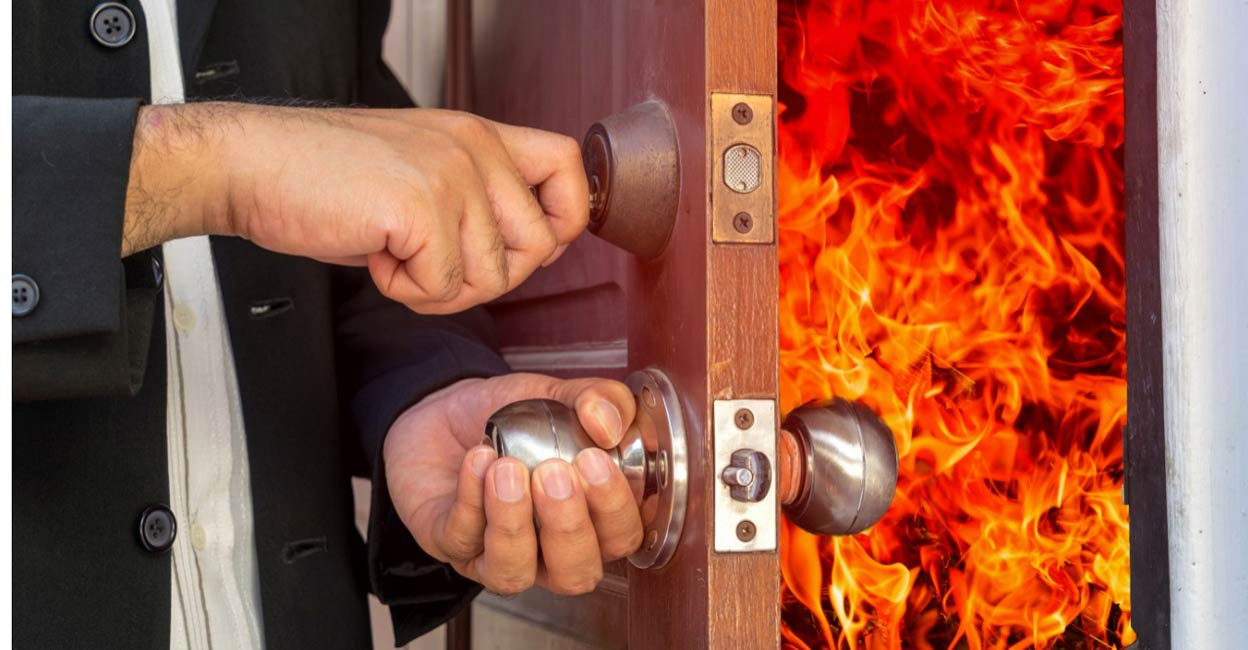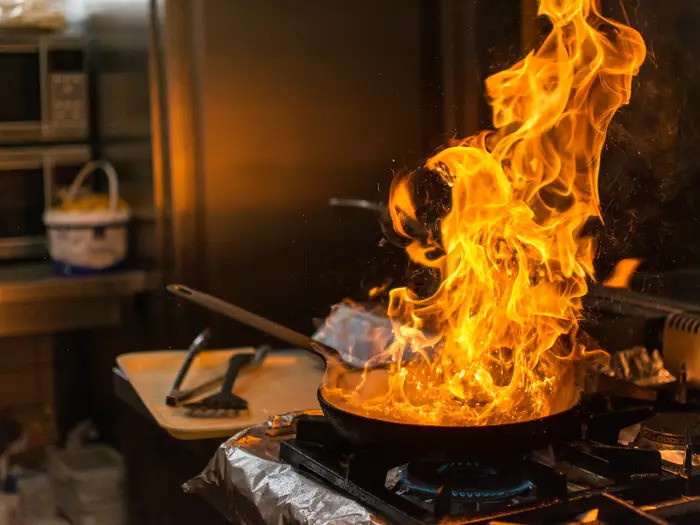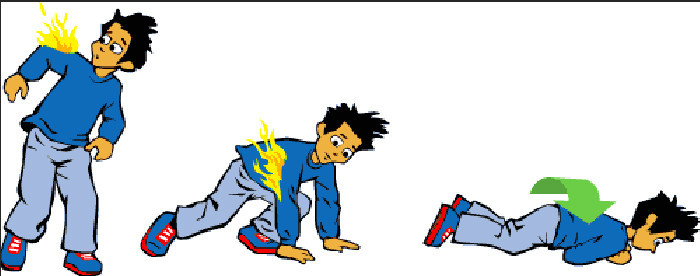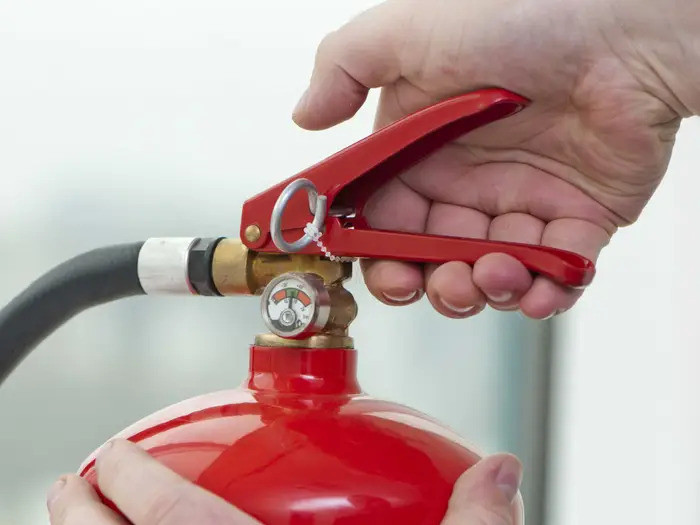Fires can happen anywhere. Knowing what to do and what not to do in the event of a house fire can help save your life and the lives of your loved ones. Making the wrong decision can sometimes have serious consequences, even leading to death.
Insider consulted fire experts and listed the most dangerous mistakes people make when there is a fire.
When a fire breaks out in a building, most people's instinct is to run away from the area. This often means opening doors to find an escape route. Unfortunately, opening a door (especially one that feels warm to the touch) is one of the worst mistakes you can make in the event of a fire.
"Fires need oxygen to sustain themselves, and opening a door will provide oxygen for the fire to burn more vigorously," Steve Kerber, director of the UL Firefighter Safety Research Institute, told Insider.
Although a door can eventually burn through a fire, even wooden doors can be an effective short-term barrier to flames and oxygen. Instead of immediately opening the door, first check for other exits that the fire has not spread to, or try to escape through a window if it is safe to do so.

Additionally, when moving into any building, you should plan ahead in case of fire by carefully mapping out and memorizing emergency exits. If possible, this plan should include at least two ways out of each room in the event of a fire.
In case you have no other way out and need to escape through that door only, remember to close the door so that the fire does not get more oxygen and create a big fire.
New York City firefighter Christopher Doyle also told Insider that closing the door when you leave a burning area can help firefighters a lot.
Dense smoke from a house fire can quickly overwhelm and suffocate anyone trapped inside, so many people assume that breaking windows from the outside will make it easier for those inside to breathe. This is usually a bad idea, especially in the case of a house fire.
“In a house fire, don’t break a window thinking you can provide more air to people trapped inside — that just increases the intensity of the fire,” said David Icove, a fire investigator and professor at the Tickle School of Engineering at the University of Tennessee.

It's no surprise that many home fires start in the kitchen. The combination of flammable oil, heat, and flames can lead to a fire in a pot or pan.
"For cooking fires, don't take a burning pan off the stove and throw it outside. This is a very common practice and often spreads the fire because the burning grease gets scattered everywhere," advises Zack Zarrilli, a firefighter.
Attempting to move a burning pan or pouring water onto the pan can also cause second- and third-degree burns to the cook's hands, arms, and legs as hot grease splatters.
Instead, put a lid on the pot or pan or a metal plate over it and turn off the heat. This will help smother the flames. Only remove the lid when the pot or pan has cooled completely to ensure the fire does not reignite. If it is a small grease fire, try pouring in a generous amount of baking soda, as this can also help smother the flames.
If the above methods do not work, use a fire extinguisher or call the fire department.

If your clothes catch fire, your natural reaction is to run or flail around trying to put out the fire. Unfortunately, this is probably the worst thing you can do in this situation. This is because moving around will only spread the fire, especially if you bump into other people or objects.
Instead, the Red Cross recommends “stop, drop and roll” until the fire is out.
You should have a fire extinguisher in your home, especially near areas with heat or electricity, such as the kitchen or workshop. It is important to know how to use it correctly.
“The most common mistake people make when using a fire extinguisher is aiming too high at the fire,” Zarrilli told Insider. “Aim low at the base of the fire for the best effect.”

“When using a fire extinguisher, pull the pin, aim at the base of the fire, squeeze the trigger and sweep from side to side. Think of it like you’re killing a weed, if you don’t attack the root, it will grow back.”
If you keep fire extinguishers in your home, be sure to check them regularly to make sure they are in good working order. Miniature fire extinguishers should be replaced every few years.
According to experts, a small fire can become a major fire in less than 30 seconds. And in just 5 minutes, a fire can burn down an entire building. If you cannot put out the fire while it is still small, leave the building and call emergency services.
"Don't try to put out the fire yourself," Doyle advises. "Every second that passes increases your chances of inhaling smoke. Stay low and get away from the fire as quickly as possible."
This applies even if you have a fire extinguisher. If you spray a small fire and it does not go out immediately, the safest option is to drop the extinguisher, leave the area, and call for help.
“If your house is on fire, you should never go back in,” Zarrilli advises. “If you have pets or anything extremely valuable inside, wait outside and show firefighters where to go.” Because it only takes seconds for smoke to hit you and make you unconscious.
Turning back could actually be more dangerous for trapped loved ones and rescue teams.
| Things to remember when living in an apartment 1. Turn off electrical appliances and cut off the power (turn off the circuit breaker) when leaving the house. Discard old, damaged electrical appliances and wires that are no longer connected because they can cause fires. 2. A 50m2 room will be completely engulfed in smoke and fire in about 3-5 minutes, depending on whether the house has a lot of stuff or not, the more stuff the bigger and faster the fire will burn. However, if detected early and handled promptly, it will be fine, with little damage, and the whole family will be safe. Buy at least 1 fire extinguisher for the family, which can be used in emergencies. 3. 90% of deaths in fires are due to smoke inhalation. Buy each family member a smoke mask to keep their lives safe. 4. If there is a fire in the apartment building: - Check to see if the fire escape is filled with smoke. If there is no smoke, you can calmly enter; there is no need to run. If there is smoke, you should not enter. - If the fire escape or hallway is heavily contaminated with smoke: + Close the doors inside the house, use tape to cover the cracks in the doors to prevent smoke from getting inside. + The whole family can go out to the balcony, hold flashlights as a signal and wait for the fire department. If there is smoke coming from the balcony, put on a mask and wait there. + Never go into the bathroom and close the door. Do not follow the movies and tie your clothes into a rope to pull them down. 5. In case of fire, dial 114 immediately. |